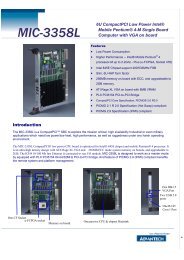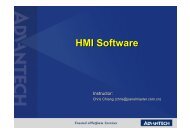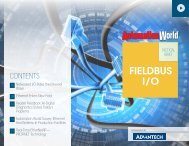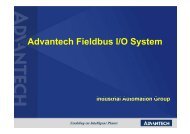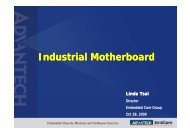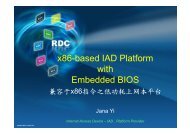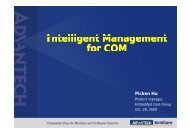industrial wireless book special edition - Networking ...
industrial wireless book special edition - Networking ...
industrial wireless book special edition - Networking ...
Create successful ePaper yourself
Turn your PDF publications into a flip-book with our unique Google optimized e-Paper software.
Transportation<br />
Car to roadside communication<br />
using IEEE 802.11p technology<br />
Provision of external services to vehicles has – until recently – been limited because of the lack of highspeed<br />
communications between them and service providers. The lack of standardised communications<br />
interfaces between various car manufacturers hasn’t helped. The IEEE 1609 family of standards for Wireless<br />
Access in Vehicular Environments (WAVE) addresses these issues. Josef Jiru reports.<br />
14<br />
THE EC has launched a Road Safety programme<br />
aimed at cutting the number of road deaths by<br />
half from 2011-2020. To help achieve this<br />
objective, a number of organisations have been<br />
carrying out research and development into<br />
car-to-roadside communication techniques.<br />
Among them is Fraunhofer ESK, the Munichbased<br />
institute that undertakes applied<br />
research into networked information and<br />
communication systems. The institute has been<br />
working on networking vehicle and the communication<br />
infrastructures (Fig. 1) to provide<br />
drivers with a more complete operational<br />
perspective of the vehicle, which can add to<br />
safety.<br />
Early warning detection of road construction<br />
or accidents can also be provided to reduce<br />
road congestion. In addition, linking the<br />
vehicle and its environment enables optimal<br />
use of existing infrastructures.<br />
Ultimately, nationwide, Europe-wide and<br />
global networks are needed to enable communications<br />
between all vehicles and roadside<br />
access points, or other vehicles.<br />
IEEE 802.11p<br />
Car-to-roadside communication is based on a<br />
WLAN (IEEE 802.11p) platform developed<br />
e<strong>special</strong>ly for vehicles, while IEEE 1609 is a<br />
higher layer standard on which IEEE 802.11p is<br />
based. IEEE 802.11p is an approved amendment<br />
to IEEE 802.11 that adds WAVE. It therefore<br />
defines the enhancements to 802.11 required<br />
to support Intelligent Transportation Systems<br />
(ITS) applications.<br />
WAVE standards define an architecture and a<br />
complementary, standardised set of services and<br />
interfaces that together enable secure vehicleto-vehicle<br />
(V2V) and vehicle-to-infrastructure<br />
(V2I) <strong>wireless</strong> communications. Transportation<br />
benefits include greater vehicle safety, better<br />
navigation and traffic management, plus<br />
automated tolling.<br />
Note that 802.11p will also be the basis for<br />
Dedicated Short Range Communications (DSRC).<br />
Based on the ISO Communications, Airinterface,<br />
Long and Medium range (CALM)<br />
architecture standard, this is a US Department<br />
of Transportation project that addresses vehiclebased<br />
communication networks, e<strong>special</strong>ly toll<br />
collection, vehicle safety services, and<br />
commerce transactions via cars.<br />
Fig. 1. Intelligent Transport Systems (ITS) include all types of communications in vehicles, between vehicles and between<br />
vehicles and fixed locations. Such systems include the use of information and communication technologies (ICT) for rail,<br />
water and air transport (picture ETSI).<br />
<strong>industrial</strong> ethernet <strong>book</strong><br />
The technology<br />
The car-to-roadside communication that<br />
Fraunhofer ESK has been looking at is based on<br />
this WLAN IEEE 802.11p platform. It is combined<br />
with a satellite positioning system to enable the<br />
exchange of vehicle positioning and sensor data<br />
with the vehicle’s environment. The Universal<br />
Mobile Telecommunications System (UMTS) can be<br />
used as an alternative or additional technology.<br />
For time critical applications, however, UMTS can<br />
only be considered conditionally because the<br />
transmission of timed messages with short delays<br />
cannot yet be guaranteed.<br />
The system will have to operate at vehicle<br />
speeds of up to 200km/h and support a transmission<br />
range of 1km. These requirements place<br />
high demands on the <strong>wireless</strong> communication<br />
network. Scalable transmission power will help<br />
avoid collisions on the <strong>wireless</strong> segment when<br />
traffic is highly dense. To enable time-critical,<br />
safety-relevant applications, the data will be<br />
prioritised and partitioned into different channels.<br />
Because of the potential high vehicle speeds,<br />
topological changes are continuously generated<br />
that place many demands upon routing functionality.<br />
Many routing algorithms are available,<br />
but so far none has been found to be adequate<br />
on its own. A situation-dependent, hybrid<br />
solution is therefore needed.<br />
On Board Units (OBUs) and the Roadside Units<br />
(RSUs) (Fig. 2) were designed for the demonstrator.<br />
These are based on embedded hardware<br />
and real-time Linux. The RSUs are linked in a<br />
multi-hop, fault-tolerant meshed network, with<br />
the routing protocol being based upon modified<br />
Optimised Link State Routing (OLSR) protocol.<br />
This is an optimisation of the classical link state<br />
algorithm adjusted to the requirements of a<br />
mobile <strong>wireless</strong> LAN. Multipoint relays (MPRs)<br />
are selected nodes that forward broadcast<br />
messages during flooding. The technique significantly<br />
reduces the message overhead compared<br />
with classical flooding, where every node<br />
retransmits each message when it receives the<br />
first message copy.<br />
The current network topology is then<br />
displayed in real-time in the form of graphs,<br />
and the RSUs offer a variety of services through<br />
the meshed network. Requested services or<br />
services in the near vicinity of the vehicle can<br />
sponsored by Advantech



